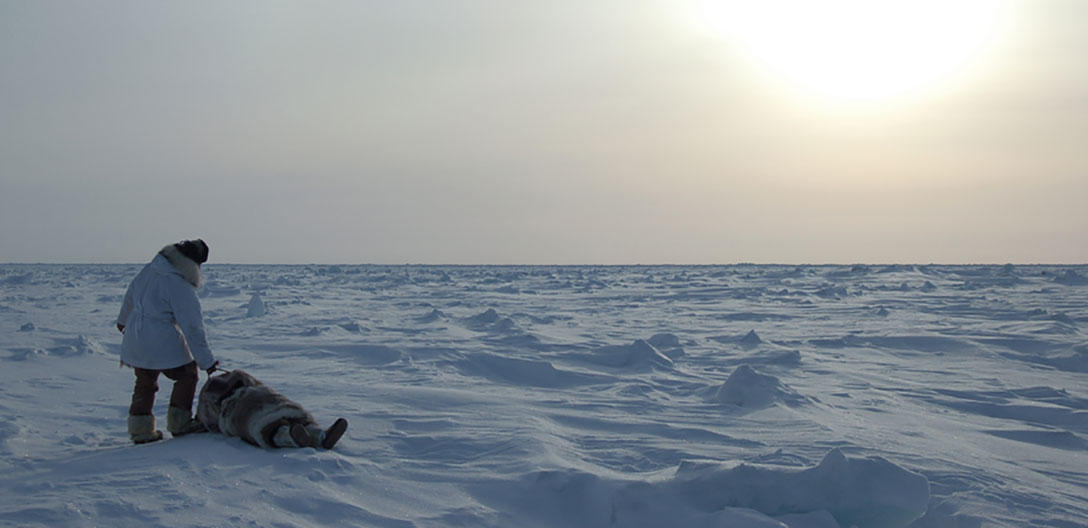On the Ice
Bird Runningwater
In 1990, November was officially recognized as National American Indian Heritage Month. The years since have proven to be both a political and artistic resurgence for Native Peoples.
From the early support of Greg Sarris’s (Coast Miwok) Grand Avenue at Sundance Institute’s 1992 June Screenwriters Lab to the premiere of Chris Eyre’s (Cheyenne/Arapaho) Smoke Signals in 1998, supporting and celebrating Indigenous creativity has been a longtime mission of Sundance Institute.
The Indigenous Program became a formal addition in 1994, and as we reflect on the last 25 years of honoring Native American Heritage Month, we also want to recognize the contributions of Native filmmakers who have been supported by the Institute.
This May Be the Last Time
In 1962, filmmaker Sterlin Harjo’s grandfather disappeared mysteriously in Sasakwa, Oklahoma, and as the Seminole community searched for him, its members sang ancient songs of faith and hope. Interviewing everyday people and the faith keepers of his tribe, Harjo traces the creation of their songs, which commemorate a great time of upheaval from their homeland when United States policy dictated their relocation. Sculpted with an aching sense of beauty, This May Be the Last Time reminds us that despite the hardships at hand, we can sing our way into the future and that forgiveness is essential if we want to move forward in life.
Smoke Signals
Simply put, director Chris Eyre’s Smoke Signals is a superbly told, deeply moving portrait of coming to terms with one’s father. His direction of novelist/screenwriter Sherman Alexie’s tale of a young man’s journey to retrieve his estranged father’s body for burial is full of the kind of truth, spirit, and insight that only a remarkably original and genuine voice can offer. Funny, raging, poignant, and revealing, Smoke Signals is a story told from a very personal point of view. As specific as it is, its payoffs are powerfully universal. Adam Beach heads a wonderful cast, which includes Evan Adams as Thomas, and Gary Farmer and Tantoo Cardinal as Victor’s parents.
Drunktown’s Finest
Drunktown’s Finest is filmmaker Sydney Freeland’s response to a news story that characterized her hometown of Gallup, New Mexico, as “Drunktown, USA.” Nizhoni was adopted and raised as a Christian by a white family, transsexual Felixxia dreams of becoming a model, and Sickboy is headed to basic training so he can take care of his soon-to-be-born child. Shot against a mesmerizing New Mexico landscape, we observe the Navajo Nation from the inside out through the eyes of these three unlikely characters. At first our preconceptions are reinforced, but slowly, as each of their lives unfolds, we start to wonder whether the outside world these characters crave is truly the answer.
Grab
Director Billy Luther gives audiences an intimate look inside one of his own Native American tribes, where cameras have never been allowed before. Each year residents of the Laguna Pueblo in New Mexico honor individual family members by throwing food and gifts from the rooftops of their homes to the community that gathers below. Luther’s film follows three families as they prepare for this ancient tradition, which has taken many modern twists. Photographing with great visual flair, Luther sculpts an emotional tribute to his community, a community that’s filled with abundant generosity and rooted in tradition.
On the Ice
In this utterly engrossing, suspenseful film by Andrew Okpeaha MacLean, Iñupiaq teenagers Qalli and Aivaaq have grown up like brothers in a tight-knit, Alaskan community defined as much by ancient traditions as by hip-hop and snowmobiles. Early one morning, on a seal hunt with their friend James, a tussle turns violent, and James is killed. Panic stricken, terrified, and with no one to blame but themselves, Qalli and Aivaaq lie and declare the death a tragic accident. As Barrow roils with grief and his protective father becomes suspicious, Qalli stumbles through guilt-filled days, wrestling with his part in the death. For the first time in his life, he’s treading alone on existential ice.
Trudell
Filmmaker Heather Rae demonstrates sophisticated craft and builds an Indigenous aesthetic essential to the intellectual exploration of the power and fragility of an Indigenous icon, John Trudell. With Trudell’s lifeline as the narrative thread, this biopic journeys in and out of modern Indian history and politics, exploring the earth-infused philosophy and motivations of Trudell’s radical acts and thought, as well as reliving the loss and heartache that prompted his activism to evolve abruptly into artistic expression. Rae gently sculpts the space between all things John Trudell and the rest of us, slowly and deliberately revealing the soul of a rare man who is one of the most influential Native activists of our times.




